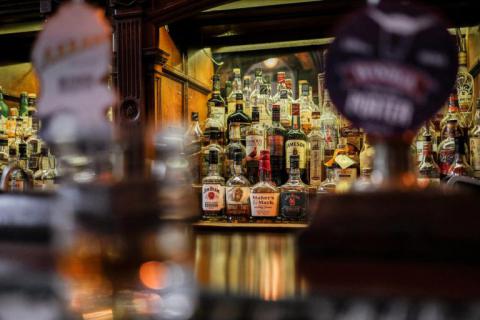What's the Difference in Types of Whiskey?
Bourbon, Scotch, Canadian, Irish and Tennessee ... What's Your Favorite?
When you pour glasses of Buffalo Trace (bourbon), Dalmore (Scotch), Forty Creek (Canadian whisky), Bushmills (Irish whiskey) and Jack Daniels (Tennessee whiskey), then compare the looks of each, you might think they’re pretty similar.
The depth of the color may be close enough that a novice might think they were drinking similar spirits.
But there are more differences than meet the eye when comparing bourbon to Scotch or other types of whiskey. How do you know the difference if you’re new to bourbon? Let’s first take a look at how each is made.
Bourbon
Bourbon’s mash bill begins with a 51% corn base. It also must be stored in new charred oak barrels, distilled at 160 proof or less and stored at no more than 125 proof. And it must contain no additives. To be labelled “straight bourbon”, it has to be aged for a minimum of two years.
Bourbon mash bills vary greatly depending on the distiller and the distillery. For example, wheated bourbons (bourbons with a higher wheat percentage) will typically be sweeter than, say, a high-rye bourbon.

Scotch
Scotch whisky (minus the “e”) is made where the name indicates, in Scotland. It is almost always a 100% barley mash bill. Some mix in rye and wheat now and then, but it's not much of a variation from all barley/malted barley, all the time. Scotch also must be aged for no less than three years.
There are five different regions of Scotland where Scotch can come from: Highlands (The Macallan, for example), Lowland (Bladnoch), Islay (Laphroaig), Speyside (Glenfiddich), and Campbeltown (Springbank).
Canadian
Distillers in Canada tend to distill grains individually, barrel and age them separately, then blend them after a minimum of three years of aging. However, some Canadian distilleries do use mash bills that range from 100% corn to other blends of corn, rye, and malted barley.
Canadian Whisky (also minus the “e”) must be made in Canada, aged for at least three years and contain some percentage of rye grain. In fact, in Canada, when people say they drink “rye whisky” they’re often referring to Canadian whisky specifically.
Irish
Irish whiskey must be made in Ireland and aged in wooden barrels or casks for a minimum of three years. The mash bill for the spirit is made mostly of non-peated malt, unlike Scotch, which is often made with peated malt with the option to add other cereal grains. Irish whiskey can even contain caramel coloring and water, but nothing else.
It must be mashed, fermented and distilled to no less than 80 proof. It can be made as high as 189.6 proof, however.
Tennessee
The biggest difference between Tennessee whiskey and bourbon is found in filtration. Tennessee whiskey is filtered through sugar maple charcoal in order to make the libation “cleaner” and remove “unpleasantries”, as explained by the makers. The process is often referred to as mellowing the bourbon. (Yes, Tennessee whiskey is bourbon. Just bourbon that has been filtered as a finishing process.)
So what does all of that mean for the flavors of whiskies?
Each whiskey (or whisky) has their own unique flavor profiles born from their mash bills, yeast strains, proof in and out of the barrel, and aging. It’s impossible to sum up their flavor profiles in comparison to each other.
Some recommend if you’re looking for something lighter and a little sweeter, especially if you’re new to whiskey, Canadian whisky is a good place to start. It’s sweetness blends well in cocktails.
But as always, we recommend running your own taste tests. Set up flights with samples of popular brands of each. Have your friends over to taste, compare and rate each. (Be sure to drink responsibly.) You’ll get a better idea of what your palate prefers.
Comparisons
Your flight should include up to three tastes of each: bourbon, Scotch, Canadian, Irish, and Tennessee whiskies.
The chart below is just a suggestion, feel free to design your own flights.
| Bourbon | Scotch | Canadian | Irish | Tennessee |
| Buffalo Trace | Laphroaig | Crown Royal | Jameson | George Dickel |
| Maker’s Mark | The Macallan | Forty Creek | Tullamore Dew | Jack Daniel’s |
| George T. Stagg | Johnnie Walker | Masterson’s | Writer’s Tears | Corsair |
After you choose your favorite within each category of whiskey, compare the top choice to the other category winners. This type of exercise helps you understand the nuances between each type of whiskey and learn more about what category pleases your palate most.
Editor's Note: Photo by Adam Wilson on Unsplash
